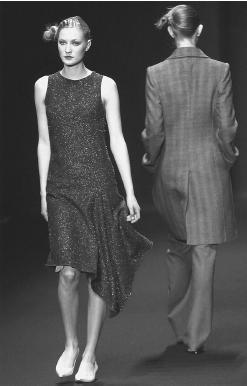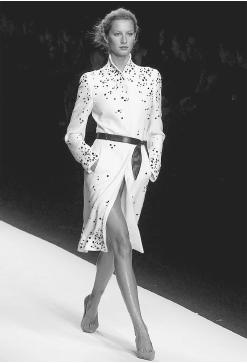BYBLOS - Fashion Designer Encyclopedia
Italian fashion house
Founded: in 1973 as a division of Genny SpA. Company History: Independent company formed, circa 1983; designers have included Versace and Guy Paulin; principal designers, since 1981, Alan Cleaver and Keith Varty; collections include Byblos Uomo, 1983, Byblos USA, and Options Donna, 1985, Vis á Vis Byblos, 1986, and

Publications
On BYBLOS:
Articles
Buckley, Richard, "Byblos: The Boys' Own Story," in DNR: The Magazine (New York), January 1985.
Haynes, Kevin, "Leave It to Byblos," in Women's Wear Daily, 5 June 1985.
Elms, Robert, "Italian Fashion: The British Connection," in the Sunday Express Magazine (London), 9 February 1986.
Frey, Nadine, "Varty and Cleaver: Revitalizing Byblos," in Women's Wear Daily, 28 April 1987.
Harris, Lara, "La Sera di Byblos," in Donna (Milan), October 1987.
Phillips, Kathy, "Men of the Cloth," in You, magazine of the Mail on Sunday (London), 8 November 1987.
Lomas, Jane, "Byblos Brits," in the Observer (London), 24 April 1988.
Cook, Cathy, "Boys Just Wanna Have Fun," in Taxi (New York), March 1989.
Racht, Tione, "Der Byblos Stil," in Vogue (Munich), March 1989.
Lobrano, Alexander, "Both Sides of Byblos," in DNR, 19 June 1989.
Ozzard, Janet, "Byblos Boys Out After 15 Years, as Milan Firm Appoints Richard Tyler," in Women's Wear Daily, 12 November 1996.
Conti, Samantha, "Behind the Purge at Byblos," in DNR, 4 December 1996.
Forden, Sara Gay, "Cleaver and Varty Seeking Compensation From Byblos," in Women's Wear Daily, 31 July 1997.
Conti, Samantha, and Miles Socha, "Bartlett Already Sketching for Byblos," in Women's Wear Daily, 9 April 1998.
Ilari, Alessandra, "Bartlett Paring Down His Steamy Side for Byblos Collection," in DNR, 26 June 1998.
Ozzard, Janet, "Bartlett, Byblos Part Company," in Women's Wear Daily, 21 March 2000.
Dodd, Annmarie, et al., "Bartlett to Take Front Row Seat at Byblos," in DNR, 26 June 2000.
"Byblos Appoints Martine Sitbon as Women's Creative Director," in Women's Wear Daily, 19 March 2001.
Brown, Wendell, "Byblos Names Sandy Dalal Creative Director," in DNR, 21 March 2001.
***
Byblos takes its name from a hotel in St. Tropez, France. Since its inception in 1973, it has been a kind of international grand hotel of design, starting with a group of stylists, then engaging the Milanese Gianni Versace as designer from 1975 to 1976, then Frenchman Guy Paulin, and finally Keith Varty from the Royal College of Art in

What Varty and Cleaver lacked was any sense of the sinister or cynical: they were intent upon making clothes that were fun and exuberant. Varty described their design challenge to Women's Wear Daily in 1987: "Our product has to be salable, in the right fabrics with this young image and it's got to be fresh every season." The crux of the Cleaver-Varty achievement was color—they brought Matisse colors to clothing, captured aubergines and gingers with a grocer's discrimination and knew the earth colors of every part of the globe with a geologist's imagination. The Daily News Record (11 January 1989) rightly described the menswear: "Gold at the end of the rainbow. If anyone can make color successfully commercial, it's Keith Varty and Alan Cleaver for Byblos." They were to contemporary fashion what David Hockney is to contemporary art: British travel, observation, effervescence, and childlike delight in the world's bright colors.
Travel and exoticism was an important theme in Cleaver and Varty's work, reflecting their vacationing in Marrakech, Hawaii, and the South Pacific; a recurring spirit of the American West (especially in their menswear); old-Havana machismo; and their love of tropical colors and refreshing prints inspired by Southeast Asia and South America. In 1987 resort collections, the voyage was specific, with big skirts featuring postcards from the Bahamas and maps of islands. Fiesta brights were almost invariably featured in the spring and resort collections, with options for khaki, chocolates, mud, and tobacco brown. If the spring 1987 collections seemed like the British in India, their colonialism was mellowed by supple shapes, fluid lines, and khaki silk poplin. In 1988, the trek was to Russia in a savagely romantic display of fake fur, folkloric embroidery and motifs, and grand silhouettes that Women's Wear Daily (29 February 1988) called "Anna Karenina comes to Milan."
It seemed unlikely that the sun would ever set on these two brilliant adventurers who had done so much to establish the Byblos style. Yet Byblos experienced turmoil and turnover beginning in the mid-1990s and in 1996 Varty and Cleaver were dismissed after 15 years with the company. Sales had been in decline, and the two were accused of a lack of innovation; while the remainder of the fashion industry was moving on to more sophisticated, elegant creations, they continued with the fun, colorful fashions they had been known for since the early 1980s.
Varty and Cleaver's replacement was Richard Tyler, who debuted his first Byblos collection in Milan for fall 1997. Tyler's emphasis on simplicity in his designs, along with his popularity in the U.S., where Byblos generated 10 percent of its sales at the time were two of the factors that encouraged Byblos' parent company, Genny, to hire him. Tyler, who continued to design his own label concurrently with his work for Byblos, lasted only a year and a half with the house, being replaced by John Bartlett in 1998.
Bartlett, whose first collection was for spring/summer 1999, recognized the need to stay true what he characterized as the Byblos tradition of "young, light, colorful, and thematic" clothing ( Women's Wear Daily, 9 April 1998), while moving forward to embrace current design trends. Color was something the brand had gotten away from under Tyler's oversight, when minimal and monochromatic were the rule of the day. Bartlett set out "to reinvigorate and revitalize the Byblos brand without completely changing it beyond recognition," as he told Women's Wear Daily. At the same time, Bartlett had to tone down the sexiness typical of his own line, in a bow to Byblos' commercial direction.
Bartlett's short reign lasted just over a year, when he stepped down after completing the fall 2000 collections. (Byblos and Barlett simultaneously discontinued a licensing deal that had allowed Byblos to manufacture and distribute Bartlett's signature line.) Bartlett stayed on as a consultant on fashion trends for two seasons but did no hands-on designing at Byblos. An in-house design team took over, garnering lukewarm reviews for the homogeneity of their early collections. As Women's Wear Daily pointed out in October 2000, Bartlett had creative highs and lows during his tenure, but his signature style always showed through. The subsequent line, on the other hand, "lacked the singular focus that would distinguish it from a sea of others."
In March 2001, Byblos announced two new creative directors, Martine Sitbon for women and Sandy Dalal for men. Paris-based Sitbon was recognized for her use of graphic prints and according to Women's Wear Daily, "a style that blends rock 'n' roll with romance." The 24-year-old Milan-based Dalal, who planned to continue his own signature collection in addition to his work for Byblos, told DNR (21 March 2001) that he looked forward "to reinterpreting the essence of the roots from which Byblos began: playful, sexy, colorful clothes." Debut collections were expected from the designers for spring 2002.
—RichardMartin;
updated by KarenRaugust